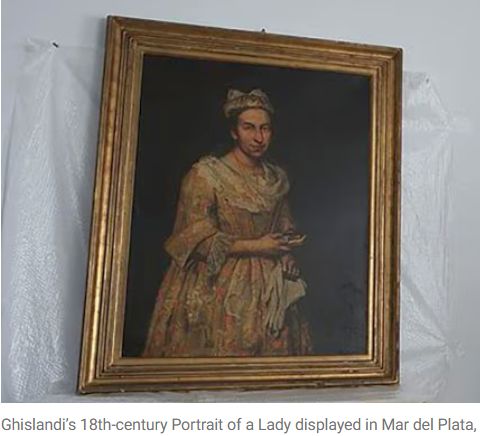In Mar del Plata appeared a painting attributed to Giuseppe Ghislandi (Portrait of a Lady, Countess Colleoni), looted in 1940 from the collection of the Jewish dealer Jacques Goudstikker, whose gallery of more than 1,100 pieces was plundered after the German invasion of the Netherlands. Since 1946 the work was in the hands of Friedrich Kadgien, a Nazi officer who first took refuge in Switzerland and then settled in Argentina. A few days ago, some journalists identified her at the home of her daughter Patricia. After a search and momentary disappearance, she was handed over to justice.
The case raises multiple legal questions. There is no specific and binding treaty in current international law that obliges States to return works plundered by Nazism. In 1998, Argentina signed the Washington Principles, which call for just and equitable solutions. However, they lack mandatory force, and their application is limited to public collections, while here it is a property in private hands. In 2009 our country also adhered to the Terezin Declaration, also non-binding.
Various international treaties offer general guidelines, but none directly resolves this case. The Hague Convention of 1954 focuses on the protection of cultural property in armed conflicts and establishes the obligation to safeguard heritage against damage, theft or looting. Although supplemented by a Protocol providing for restitution, it is not applicable, since no sovereign States intervened and there was no armed conflict. The 1970 UNESCO Convention prohibits the illicit export of cultural property but only applies to events after its entry into force in 1972. The 1995 Unidroit Convention establishes mechanisms for the restitution of stolen or illicitly exported goods. It has been in force since 1998, but its implementation has been hampered by the time that has passed.
In this context, a possible claim by the Goudstikker heirs should be channelled through a formal request from the Netherlands to Argentina. If successful, the current owner could claim equitable compensation if she proves ignorance of the illicit origin and diligence in the acquisition. The evidentiary difficulty is obvious: it is an inherited asset within the family, transmitted from father to daughter, which makes it unlikely that documentary verifications have been carried out.
At the domestic level, Patricia Kadgien promoted an action of acquisitive prescription. The civil regulations provide that stolen movable property is time-barred in favor of the possessor after two years of uninterrupted possession. However, it could be argued that the Nazi appropriation constituted a war crime and that, consequently, the statute of limitations is not applicable. This thesis runs into an obstacle: neither Kadgien nor his father were ever convicted of a war crime, an extreme that should first be proven.
The Goudstikker heirs could try a vindication action. The law establishes that, in the claim of non-registrable movable property, the derived right of the oldest ancestor prevails. It even recognizes priority to a right that dates back to an original acquisition, even if it is later in time. In addition, the rule declaring civil actions arising from crimes against humanity imprescriptible could serve as a basis, provided that the commission of such a crime is effectively proven, which is not proven in this case.
A possible litigation would have international repercussions, since the interpretation of Argentine law, the commitments assumed by the country and the moral demands of the victims of the Holocaust would be put at stake. The controversy goes beyond the strictly legal and is projected in the field of historical memory and the ethical legitimacy of preserving plundered goods.
Finally, the practical consequences should be pointed out. In the hands of the Kadgiens, the portrait is unsaleable today: no gallery or serious collector would risk their reputation or money on a piece associated with Nazi plunder. It would be impossible to plead good faith. The only reasonable way for the possessor would be to negotiate with the heirs a voluntary restitution, even accepting a symbolic compensation. If you do not do so, you will be left as the owner of a legally questionable asset with no economic value, the mere possession of which implies a high reputational cost.
In conclusion, the case illustrates the tension between internal norms, international commitments and moral demands. The absence of a specific binding framework, the evidentiary difficulty and the intergenerational transmission make restitution uncertain. From the ethical and practical point of view, the preservation of the painting in private hands seems unsustainable: it will remain an uncomfortable testimony of Nazi barbarism and the insufficiency of law to fully repair its consequences. A cursed inheritance.

Lawyer; Judge of the Arbitral Tribunal for the Arts, The Hague; member of the Committee for Cultural Policy, USA.
Author:
Juan Javier Negri
Negri & Pueyrredon
Montevideo 850 Piso 1
C1019ABR
Buenos Aires
Argentina
+54 11 5556 8000
javier_negri@negri.com.ar
https://laworld.com/member_firms/negri-pueyrredon/


